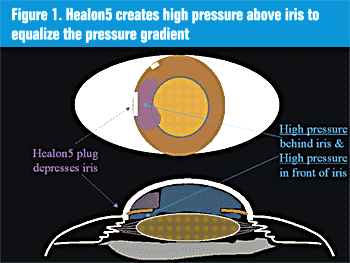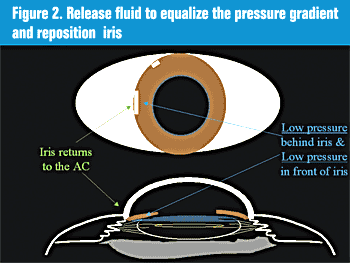Iris prolapse managed by equalizing pressure gradient
 Uday Devgan |
During cataract surgery, the iris can prolapse out of the incision, causing difficulty with the surgery and damage to the delicate iris.
There are factors that make the iris more likely to prolapse out of the incision: a lack of tone, an inadequately dilated pupil, a poor clear corneal incision and a shallow anterior chamber. However, the reason behind the iris prolapse is always a pressure gradient.
Pressure gradients cause iris prolapse
Equalizing the pressure gradient is instrumental in solving the problem of intraoperative iris prolapse.
Prolapse of the iris during phaco or cortex removal is due to the creation of a high-pressure state. The infusion pressure from the hanging bottle can create IOPs in excess of 50 mm Hg. When this inflow is under the iris, prolapse can occur. Other sources of pressure posterior to the iris can worsen this pressure gradient.
Any time the pressure behind the iris is greater than the pressure in front of it, the iris will tend to prolapse out of the incision. The treatment is always the same: equalize the pressure gradient. This can be done by either raising the pressure above the iris or lowering the pressure behind the iris. Once the pressure gradient has been neutralized, the iris will return to its natural position.
Equalize by raising pressure
When the iris prolapses out of the incision during phaco or cortex removal, the best treatment is to raise the pressure in front of the iris. Because there is already a high-pressure state behind the iris due to the infusion pressure, we need to balance this pressure by increasing the pressure in front. This can be done by re-directing the fluid inflow so that it is above the iris.
I prefer the use of a viscoadaptive device such as Healon 5 (sodium hyaluronate, Advanced Medical Optics) in order to create a plug of viscoelastic above the sub-incisional iris (Figure 1). This plug creates a constant high-pressure state above the sub-incisional iris during cataract removal. I prefer to just use a single plug of Healon 5 with the rest of the eye filled with my traditional dispersive viscoelastic.
|
Images: Devgan U |
Equalize by lowering pressure
When the iris prolapses out of the incision toward the end of the case, the best treatment is to lower the pressure behind the iris.
Simply depressing the iris and IOL and flattening the anterior chamber will immediately neutralize the pressure gradient and the iris will return to its normal position (Figure 2). The corneal incisions can then be sealed, and the eye can be re-inflated via the paracentesis. During re-inflation, if care is taken to direct the fluid on top of the iris and not below it, the iris will remain in its normal position.
|
|
For more information:
- Uday Devgan, MD, FACS, is in private practice in Los Angeles, chief of ophthalmology at Olive View-UCLA Medical Center and an assistant clinical professor at the Jules Stein Eye Institute at the University of California, Los Angeles. He can be reached at the Maloney Vision Institute, 19021 Wilshire Blvd. #900, Los Angeles, CA 90024 U.S.A.; +1-310-208-3937; fax: +1-310-208-0169; e-mail: devgan@ucla.edu; Web site: www.maloneyvision.com.


